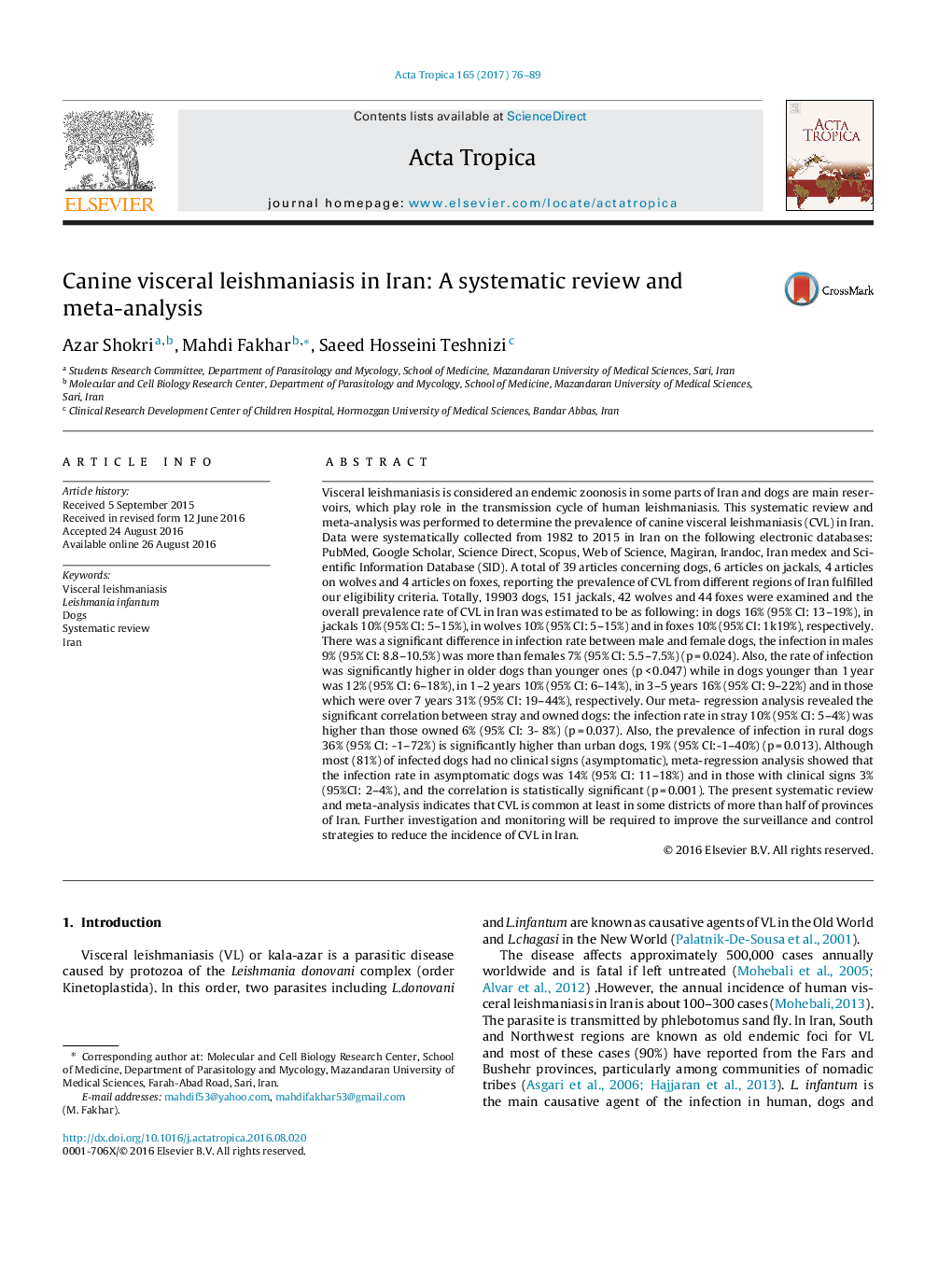| کد مقاله | کد نشریه | سال انتشار | مقاله انگلیسی | نسخه تمام متن |
|---|---|---|---|---|
| 5670823 | 1592759 | 2017 | 14 صفحه PDF | دانلود رایگان |
- We estimate the prevalence of canine visceral leishmaniasis(CVL) in Iran.
- Our analysis indicates that CVL is common at least in more than half of provinces of Iran.
- Asymptomatic stray dogs are probably act as main reservoirs in the endemic areas of the country.
- Our data shows the epizootic stability status of CVL in the investigated areas and will pose a risk for inhabitants there.
Visceral leishmaniasis is considered an endemic zoonosis in some parts of Iran and dogs are main reservoirs, which play role in the transmission cycle of human leishmaniasis. This systematic review and meta-analysis was performed to determine the prevalence of canine visceral leishmaniasis (CVL) in Iran. Data were systematically collected from 1982 to 2015 in Iran on the following electronic databases: PubMed, Google Scholar, Science Direct, Scopus, Web of Science, Magiran, Irandoc, Iran medex and Scientific Information Database (SID). A total of 39 articles concerning dogs, 6 articles on jackals, 4 articles on wolves and 4 articles on foxes, reporting the prevalence of CVL from different regions of Iran fulfilled our eligibility criteria. Totally, 19903 dogs, 151 jackals, 42 wolves and 44 foxes were examined and the overall prevalence rate of CVL in Iran was estimated to be as following: in dogs 16% (95% CI: 13-19%), in jackals 10% (95% CI: 5-15%), in wolves 10% (95% CI: 5-15%) and in foxes 10% (95% CI: 1k19%), respectively. There was a significant difference in infection rate between male and female dogs, the infection in males 9% (95% CI: 8.8-10.5%) was more than females 7% (95% CI: 5.5-7.5%) (p = 0.024). Also, the rate of infection was significantly higher in older dogs than younger ones (p < 0.047) while in dogs younger than 1 year was 12% (95% CI: 6-18%), in 1-2 years 10% (95% CI: 6-14%), in 3-5 years 16% (95% CI: 9-22%) and in those which were over 7 years 31% (95% CI: 19-44%), respectively. Our meta- regression analysis revealed the significant correlation between stray and owned dogs: the infection rate in stray 10% (95% CI: 5-4%) was higher than those owned 6% (95% CI: 3- 8%) (p = 0.037). Also, the prevalence of infection in rural dogs 36% (95% CI: -1-72%) is significantly higher than urban dogs, 19% (95% CI:-1-40%) (p = 0.013). Although most (81%) of infected dogs had no clinical signs (asymptomatic), meta-regression analysis showed that the infection rate in asymptomatic dogs was 14% (95% CI: 11-18%) and in those with clinical signs 3% (95%CI: 2-4%), and the correlation is statistically significant (p = 0.001). The present systematic review and meta-analysis indicates that CVL is common at least in some districts of more than half of provinces of Iran. Further investigation and monitoring will be required to improve the surveillance and control strategies to reduce the incidence of CVL in Iran.
157
Journal: Acta Tropica - Volume 165, January 2017, Pages 76-89
